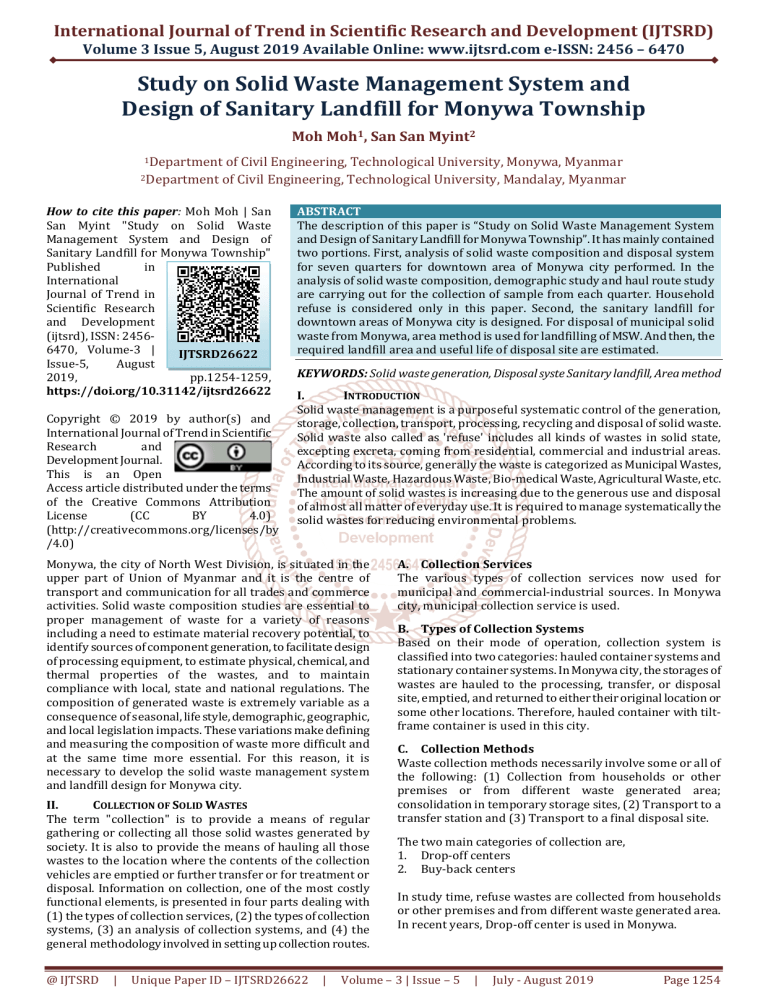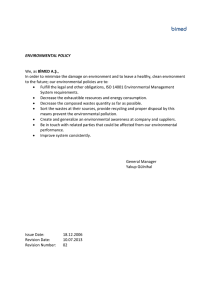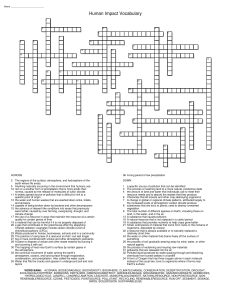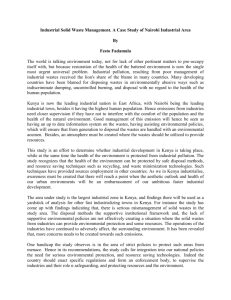
International Journal of Trend in Scientific Research and Development (IJTSRD)
Volume 3 Issue 5, August 2019 Available Online: www.ijtsrd.com e-ISSN: 2456 – 6470
Study on Solid Waste Management System and
Design of Sanitary Landfill for Monywa Township
Moh Moh1, San San Myint2
1Department
2Department
of Civil Engineering, Technological University, Monywa, Myanmar
of Civil Engineering, Technological University, Mandalay, Myanmar
How to cite this paper: Moh Moh | San
San Myint "Study on Solid Waste
Management System and Design of
Sanitary Landfill for Monywa Township"
Published
in
International
Journal of Trend in
Scientific Research
and Development
(ijtsrd), ISSN: 24566470, Volume-3 |
IJTSRD26622
Issue-5,
August
2019,
pp.1254-1259,
https://doi.org/10.31142/ijtsrd26622
Copyright © 2019 by author(s) and
International Journal of Trend in Scientific
Research
and
Development Journal.
This is an Open
Access article distributed under the terms
of the Creative Commons Attribution
License
(CC
BY
4.0)
(http://creativecommons.org/licenses/by
/4.0)
ABSTRACT
The description of this paper is “Study on Solid Waste Management System
and Design of Sanitary Landfill for Monywa Township”. It has mainly contained
two portions. First, analysis of solid waste composition and disposal system
for seven quarters for downtown area of Monywa city performed. In the
analysis of solid waste composition, demographic study and haul route study
are carrying out for the collection of sample from each quarter. Household
refuse is considered only in this paper. Second, the sanitary landfill for
downtown areas of Monywa city is designed. For disposal of municipal solid
waste from Monywa, area method is used for landfilling of MSW. And then, the
required landfill area and useful life of disposal site are estimated.
KEYWORDS: Solid waste generation, Disposal syste Sanitary landfill, Area method
I.
INTRODUCTION
Solid waste management is a purposeful systematic control of the generation,
storage, collection, transport, processing, recycling and disposal of solid waste.
Solid waste also called as 'refuse' includes all kinds of wastes in solid state,
excepting excreta, coming from residential, commercial and industrial areas.
According to its source, generally the waste is categorized as Municipal Wastes,
Industrial Waste, Hazardous Waste, Bio-medical Waste, Agricultural Waste, etc.
The amount of solid wastes is increasing due to the generous use and disposal
of almost all matter of everyday use. It is required to manage systematically the
solid wastes for reducing environmental problems.
Monywa, the city of North West Division, is situated in the
upper part of Union of Myanmar and it is the centre of
transport and communication for all trades and commerce
activities. Solid waste composition studies are essential to
proper management of waste for a variety of reasons
including a need to estimate material recovery potential, to
identify sources of component generation, to facilitate design
of processing equipment, to estimate physical, chemical, and
thermal properties of the wastes, and to maintain
compliance with local, state and national regulations. The
composition of generated waste is extremely variable as a
consequence of seasonal, life style, demographic, geographic,
and local legislation impacts. These variations make defining
and measuring the composition of waste more difficult and
at the same time more essential. For this reason, it is
necessary to develop the solid waste management system
and landfill design for Monywa city.
II.
COLLECTION OF SOLID WASTES
The term "collection" is to provide a means of regular
gathering or collecting all those solid wastes generated by
society. It is also to provide the means of hauling all those
wastes to the location where the contents of the collection
vehicles are emptied or further transfer or for treatment or
disposal. Information on collection, one of the most costly
functional elements, is presented in four parts dealing with
(1) the types of collection services, (2) the types of collection
systems, (3) an analysis of collection systems, and (4) the
general methodology involved in setting up collection routes.
@ IJTSRD
|
Unique Paper ID – IJTSRD26622
|
A. Collection Services
The various types of collection services now used for
municipal and commercial-industrial sources. In Monywa
city, municipal collection service is used.
B. Types of Collection Systems
Based on their mode of operation, collection system is
classified into two categories: hauled container systems and
stationary container systems. In Monywa city, the storages of
wastes are hauled to the processing, transfer, or disposal
site, emptied, and returned to either their original location or
some other locations. Therefore, hauled container with tiltframe container is used in this city.
C. Collection Methods
Waste collection methods necessarily involve some or all of
the following: (1) Collection from households or other
premises or from different waste generated area;
consolidation in temporary storage sites, (2) Transport to a
transfer station and (3) Transport to a final disposal site.
The two main categories of collection are,
1. Drop-off centers
2. Buy-back centers
In study time, refuse wastes are collected from households
or other premises and from different waste generated area.
In recent years, Drop-off center is used in Monywa.
Volume – 3 | Issue – 5
|
July - August 2019
Page 1254
International Journal of Trend in Scientific Research and Development (IJTSRD) @ www.ijtsrd.com eISSN: 2456-6470
D. layout of Collection Routes
The proposed collection routes for seven quarters in Monywa city with their collection frequencies are described in Tables I
and II and illustrated in Figures 1 to 7.
Table I LAYOUT COLLECTION ROUTES FOR THE SELECTED AREAS
No.
Quarters
1.
Yone-Gyi
2.
Daw-Na-Chan
3.
Pha-Ya-Gyi
4.
Sue-Lae-Gone
5.
Alae
6.
Aye-Thar-Yar
7.
Aung-Mingalar
Route
Frequency
Gallon/
Trip
R1
R2
R3
R1
R2
R1
R2
R1
R2
R1
R2
R1
R2
R1
R2
3
2
3
3
3
3
3
2
2
2
2
3
3
2
2
1
1
1
1
1
1
1
1
1
1
1
1
1
1
1
Residences
Population
Avg,
Persons/
Recidences
Day/
Wk
Trip/
Wk
6950
41779
6
7
8
6130
30652
5
7
6
5201
31211
6
7
6
2587
15524
6
7
4
3290
16452
5
7
4
4990
29942
6
7
6
3959
19797
5
7
4
Table II COLLECTED DAY WITH CORRESPONDING ROUTES FOR THE SELECTED AREAS
No.
Quarter
Route
1
Yone-Gyi
R1
R2
R3
R1
R2
R1
R2
R1
R2
R1
R2
R1
R2
R1
R2
15
2
Daw-Na-Chan
3
Pha-Ya-Gyi
4
Sue-Lae-Gone
5
Alae
6
Aye-Thar-Yar
7
Aung-Mingalar
Total
Monday
M
√
E
Tuesday
M
E
|
M
√
E
Thursday
M
√
E
Friday
M
E
√
√
√
√
√
√
√
√
√
√
√
√
√
√
√
√
√
√
√
√
√
√
Unique Paper ID – IJTSRD26622
√
√
3
4
|
E
Sun
day
M E
√
√
√
4
M
√
√
√
√
√
4
Saturday
√
√
Figure1. Collection routes for yone-gyi quarter
@ IJTSRD
Wednesday
4
4
4
√
3
4
4
figure2. Collection routes for daw-na-chan quarter
Volume – 3 | Issue – 5
|
July - August 2019
Page 1255
International Journal of Trend in Scientific Research and Development (IJTSRD) @ www.ijtsrd.com eISSN: 2456-6470
Figure3. Collection Routes For pha-ya-ghi Quarter
Figure6. Collection Routes For Aye tharyar Quarter
Figure4. Collection Routes sue-lae-gone Quarter
Figure7. Collection Routes foR aung min galar Quarter
III.
ANALYSIS OF HOUSEHOLD REFUSE
There are 33107 number of dwelling in Monywa and
township population is 185357 persons in study time. The
dwell types of in these areas mostly include single unit and
multiple low rises. The combination of socio-economic
groups is not considered for selecting sample areas. Different
places from the different disposal sites are used for
collecting the samples that takes the variations in domestic
activities. To analyze the household refuse, the container is
used to collect the refuse sample and the samples are taken
three times. And then, the wastes are separated into various
types and each refuse is weighted to make the physical
analysis. Composition of household refuse is shown in the
Following Tables and average household waste generation is
calculated.
Figure5. Collection Routes For ALae Quarter
@ IJTSRD
|
Unique Paper ID – IJTSRD26622
|
Volume – 3 | Issue – 5
|
July - August 2019
Page 1256
International Journal of Trend in Scientific Research and Development (IJTSRD) @ www.ijtsrd.com eISSN: 2456-6470
Table III. PHYSICAL COMPOSITION OF HOUSEHOLD REFUSE
(FOR 1ST TIME)
Weighted
Percent
Components
Quantities(lb)
(%)
1.Combustibles
Paper
0.5
5.17
Textiles
0.23
2.38
Vegetable & Grass
2.6
26.89
Wood
1.0
10.34
Plastic
2.26
23.37
Rubber & Leather
0.2
2.07
Kitchen waste
2.5
25.85
2.Non-combustibles
Ferrous metals
0.2
2.07
Glass
0.18
1.86
Total (lb)
9.67
100
Average household waste generation = 9.67 lb/day
.
=
= 128.96 tons/day
= 0.85 kg/cap/day
Table IV Physical Composition Of Household Refuse
(For 2nd Time)
Weighted
Components
Percent (%)
Quantities(lb)
1.Combustibles
Paper
0.7
7.06
Textiles
0
0
Vegetable & Grass
2.3
23.21
Wood
1.1
11.1
Plastic
2.61
26.34
Rubber & Leather
0.1
1.01
Kitchen waste
2.7
27.25
2.Non-combustibles
Ferrous metals
0.25
2.52
Glass
0.15
1.51
Total (lb)
9.91
100.00
Average household waste generation = 9.91 lb/day
.
=
= 132.16 tons/day
= 0.87 kg/cap/day
Table V Physical Composition Of Household Refuse
(For 3rd Time)
Weighted
Percent
Components
Quantities(lb)
(%)
1.Combustibles
Paper
0.72
7.63
Textiles
0.25
2.65
Vegetable & Grass
2.31
24.47
Wood
0
0
Plastic
2.75
29.13
Rubber & Leather
0.15
1.59
Kitchen waste
2.85
30.18
2.Non-combustibles
Ferrous metals
0.21
2.23
Glass
0.2
2.12
Total (lb)
9.44
100.00
Average household waste generation = 9.44 lb/day
.
=
= 125.89 tons/day
= 0.83 kg/cap/day
@ IJTSRD
|
Unique Paper ID – IJTSRD26622
|
According to the collected sample results, average household
waste generation of 0.85 kg/cap/day for Monywa city is
obtained.
IV.
DESIGN OF SANITARY LANDFILL SYSTEM
To use the available area at a land fill site effectively a plan of
operation for the placement of solid wastes must be
prepared. Various operational methods are developed
primarily on the basic of field experience. The methods used
to fill dry areas are substantially different from those used to
fill wet areas. The principal methods used for land filling
areas may be classified as;
1. area,
2. trench, and
3. depression.
A. Land Filling Methods and Operations
For landfill design, the area method is used for Monywa city.
Area fills are usually located in moderately rolling
topography or in large pits if cover material sources are
readily available. This method can accommodate high traffic
volumes since the working face is not limited by the size of
an excavation.
B. Forecasting of Solid Waste Generation
To forecast the solid waste generation, the prediction of
population must be calculated. For predicting population,
two methods such as Arithmetical Progression (A.P) and
Geometrical Progression (G.P) are generally used.
For Monwya city, G.P method is sufficient. Thus, the
population of the end of n years or n decades is given by the
following equation.
𝑃 =𝑃(1+
Equation 1
)
Where,
Pn = population at the end of n years or n decades
P = present population
n = years or decades
i = population increase rate
According to the census data, the population increase rate of
Monywa is taken as 2%. By using equation (1), the
population for 2024 years is forecasted. The annual solid
waste generationare calculated based on average solid waste
generation rate. These results are shown in Table VI.
Table VI PREDICTION OF POPULATION AND
FORECASTING OF SOLID WASTE GENERATION
Year
2019
2024
Population
185357 204649
Solid Waste Generation (tons) 57507
63492
C. Estimation of Solid Waste Quantities for Monywa
City
The solid wastes volume is computed by using an assumed
value of 890 kg/m3 for the in-place compacted density of the
solid wastes. The computed values can be scaled for any
other assumed density values. Solid waste generation for
Monywa city is 0.85 kg/cap/day. Based on the above data,
solid waste quantities for daily and yearly volume are
estimated and described in Table VII.
Volume – 3 | Issue – 5
|
July - August 2019
Page 1257
International Journal of Trend in Scientific Research and Development (IJTSRD) @ www.ijtsrd.com eISSN: 2456-6470
Table VII ESTIMATION Of Solid Waste Quantities
Waste Quantities
Year Population
Daily
Yearly
Volume (m3) Volume (m3)
2019
185357
177.03
64615.95
2020
189064
180.57
65908.05
2021
192845
184.18
67225.70
2022
196702
187.86
68568.90
2023
200636
191.62
69941.30
2024
204649
195.45
71339.25
D. Location of Site Selection
The most appropriate site location for solid wastes disposal
in Monywa city is selected as Sar-kyinn Cemetery landfill
site, which is located at the south of Monywa industrial zone.
The selected disposal site expends 40 acres.
E. Land Requirements of the Selected Area
Average depth of compacted solid wastes is taken as 10 ft for
this study. Estimated daily volume of solid wastes for the
year 2024 is 195.45 m3. Then, yearly area required is
calculated as,
Area required/yr =
.
(
)
(
)
.
(
)
= 5.8 acres/yr
Therefore, the useful life of the disposal site is found to be
about 7 years.
F.
Filling Plan and Operation of the Selected Disposal
Site
The landfilling method is selected as area landfill. According
to the topography of the landfill site, the first lift is started at
an elevation of 81m (245 ft), as shown in Figure and it is
filled with solid wastes to a depth of about 2.8956m (9.5 ft).
A 0.015m (6 in) layer of cover material is used to place over
the compacted fill at the end of each day. The vents are
constructed with a 0.3048m to 0.4572m (12 to 18 in) layer
of granular material so that the gases can travel to the
surface easily. The design results of cell construction are
shown in Table VIII.
Year
2019
2020
2021
2022
2023
2024
Table VIII Design Of Cell Construction
Lift Waste Volume (m3) Waste Area (m2)
1
64615.95
22315.22
2
65908.05
22761.45
3
67225.70
23216.50
4
68568.90
23680.38
5
69941.30
24154.34
6
71339.25
24637.12
Figure 8 Detail of Cell Construction to be used in
Disposal Site
@ IJTSRD
|
Unique Paper ID – IJTSRD26622
|
G. Requirements of Cover Material at the Selected
Disposal Site
The cover material for each day’s accumulation of solid
waste is taken from the sides of the fill and from the areas
where the subsequent lifts is placed. Some materials
available from excavation of the lift is used in operation.
Cover material to solid wastes is taken as 1:4.
Table IX ESTIMATION OF COVER MATERIAL
Daily solid wastes
Daily cover
Year
volume (m3)
material (m3)
2019
2020
2021
2022
2023
2024
177.03
180.57
184.18
187.86
191.62
195.45
44.26
45.14
46.05
46.97
47.91
48.86
V.
DISCUSSIONS and CONCLUSIONS
Due to increasing population in Monywa city, the daily refuse
generation also increases and threatens to the public health
and environment. Collection point should be capable of
handling of all the waste generated in its concerned area.
Layout collection and transportation routes are determined
for downtown area in Monywa city. The vehicle taking waste
from transfer station to landfill site is fully covered so that
vehicle will not cause any environmental hazard. Area of
Monywa city is 27.6 km2 and it has seven dumping site.
There are 33107 houses in Monywa city. The samples are
collected and analyzed from different places. After collection,
all the trucks dump their wastes to the nearest dumping site.
The amount of solid wastes is increasing due to the generous
use and disposal of almost all matter of everyday use.
Therefore, solid waste management system is required for
reducing environmental problems. In Monywa city,
municipal collection service is used. Based on their mode of
operation, collection system is classified into two categories:
hauled container systems and stationary container systems.
Hauled container with tilt-frame container is used in this
city. In recent years, Drop-off center method is used in
Monywa. The proposed collection routes for seven quarters
in Monywa city with their collection frequencies are
determined. For analysis of refuse, socio-economic groups
are not considered. Household refuse is considered only.
Samples are taken three times. And then, the wastes are
separated into various types and each refuse is weighted to
make the physical analysis. For landfill design, the area
method is used for Monywa city. Area fills are usually located
in moderately rolling topography or in large pits if cover
material sources are readily available. Solid waste
generation of 2024 will be forecasted because of small
available areas. According to the census data, the population
increase rate of Monywa is taken as 2%. The population for
2024 year is 204649. From refuse analysis results, the
average household waste generation of 0.85 kg/capita/day is
estimated. Solid waste generation of 2024 is 63492 tons.
Thereafter, daily and yearly waste quantities are estimated.
The most appropriate site location for solid wastes disposal
in Monywa city is selected as Sar-kyinn Cemetery landfill
site, which is located at the south of Monywa industrial zone.
Yearly area required is 5.8 acres. Therefore, the useful life of
the disposal site is found to be about 7 years according to
available amount of disposal site. According to the
Volume – 3 | Issue – 5
|
July - August 2019
Page 1258
International Journal of Trend in Scientific Research and Development (IJTSRD) @ www.ijtsrd.com eISSN: 2456-6470
topography of the landfill site, the first lift is started at an
elevation of 81m (245 ft). It is filled with solid wastes to a
depth of about 2.8956m (9.5 ft). A 0.015m (6 in) layer of
cover material is used to place over the compacted fill at the
end of each day. The vents are constructed with a 0.3048m
to 0.4572m (12 to 18 in) layer of granular material so that
the gases can travel to the surface easily. Cover material to
solid wastes is taken as 1:4. Required daily cover material is
48.86 m3 for 2024 year.
[2] Irwin/McGraw-Hill, "Environmental Engineering",
International Edition, Singapore, 1998.
REFERENCES
[1] Baljuect S. Kapoor, "Environmental Sanitation, Sh. B. L.
Ghai, resident representative of S. Chand & Co.
[6] Tchobanoglous, G. H. Theisen, and R. Eliassen., Mc
Graw-Hill New York, “Solid Waste Engineering
Principles and Management Issues”, 1977.
@ IJTSRD
|
Unique Paper ID – IJTSRD26622
|
[3] Rolf Eliasen, Paul H.King and Ray K. Linsely, Mc GrawHill series in "Environmental Engineering", 1985.
[4] S. M. Khopkar Msc, Ph.D, "Environmental Pollution
Monitoring And Control", 2005.
[5] Dr. Sadhan KGhosh, “Waste Management”, Kolkata,
2009.
Volume – 3 | Issue – 5
|
July - August 2019
Page 1259







